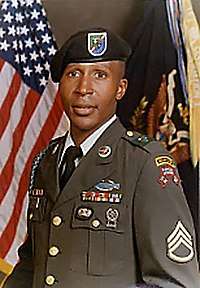United States Penitentiary, Terre Haute
 | |
 Location in Indiana  United States Penitentiary, Terre Haute (the US) | |
| Location | Vigo County, Indiana, U.S. |
|---|---|
| Coordinates | 39°24′45″N 87°27′15″W / 39.4126°N 87.4542°WCoordinates: 39°24′45″N 87°27′15″W / 39.4126°N 87.4542°W |
| Status | Operational |
| Security class | High-security (with minimum-security prison camp) |
| Population | 1,480 |
| Opened | 1940 |
| Managed by | Federal Bureau of Prisons |
The United States Penitentiary, Terre Haute (USP Terre Haute) is a high-security United States federal prison for male inmates in Terre Haute, Indiana. It is part of the Terre Haute Federal Correctional Complex (FCC Terre Haute) and is operated by the Federal Bureau of Prisons, a division of the United States Department of Justice. USP Terre Haute houses a Special Confinement Unit for male federal inmates who have been sentenced to death as well as the federal execution chamber. Most inmates sentenced to death by the U.S. Federal Government are housed in USP Terre Haute prior to execution, although there are some exceptions. FCC Terre Haute is located in the city of Terre Haute, 70 miles (110 km) west of Indianapolis.[1]
History
A new United States penitentiary was authorized by President of the United States Franklin D. Roosevelt in 1938 and established in Terre Haute, Indiana, in 1940 on 1,126 acres (4.56 km2) of land. The opening of the prison in this city was partly due to heavy promotion by Terre Haute’s Chamber of Commerce, which eventually went on to raise $50,000 to pay for the property on which the prison was built.[2] The residents of Terre Haute initially embraced the prison due to the impression that it would provide jobs to local residents in addition to helping Terre Haute’s economy while only housing non-violent offenders. E.B. Swope was the prison’s first warden.
The U.S. Public Works Administration issued a $3 million grant to pay for construction of USP Terre Haute in 1938.[2] Construction cost of the institution at the time that it was built was $2,150,000.[2] The architectural design of the prison is a modified telephone pole design with all housing and other facilities opening onto a long central corridor. It was the first penitentiary for adult felons ever to be constructed without a wall. In 2004, the new USP was built on adjoining property, with the old penitentiary becoming the medium-security Federal Correctional Institution, Terre Haute.
USP Terre Haute was one of the first federal prisons to emphasize rehabilitation by providing psychological and psychiatric treatment, referring to prisoners by names as opposed to numbers, and allowing prisoners to talk during meals instead of eating in silence. The institution initiated the use of the word "inmate" as opposed to other less-appealing labels such as "convict" or "criminal". It also became one of the first federal prisons to implement educational programs in prisons with sessions devoted to improving the inmates' skills in reading, writing, maths, as well as trades.
Camp 5, part of the Guantanamo Bay detention camps, in Cuba, is reported to have been based on the design of USP Terre Haute.[3]
Facility
USP Terre Haute is a Care Level 3 facility, which means that any inmate sent to Terre Haute who has serious health problems that are not major enough to warrant hospitalization is sent to the USP. This facility is also a tobacco-free institution. This part of the FCC contains six housing units. One of the six housing units is a faith-based unit that can house 125 inmates. When the inmates are not working, they are partaking in faith-based activities. All of the inmates in the USP are allotted seven visit-days a month and 300 minutes of telephone time, which they have to use in increments of 30 minutes or less. The inmates housed here can work at UNICOR, which is a prison industry that makes towels and other accessories for the military. Inmates employed here earn an average of $6.50 to $7.50 a day and some can make up to $12 a day if they are paid by piece as opposed to by the hour.
Death row
On July 19, 1993, the federal government designated USP Terre Haute as the site where federal death sentences would be carried out, including the establishment of the "Special Confinement Unit," the federal death row for men. The Bureau of Prisons modified USP Terre Haute in 1995 and 1996 so it could house death row functions. On July 13, 1999, the Special Confinement Unit at USP Terre Haute opened, and the BOP transferred male federal death row inmates from other federal prisons and from state prisons to USP Terre Haute.[4] There are currently 61 inmates on death row.[5][6] The federal government chose Terre Haute as the location of the men's death row due to its central location within the United States.[7]
Among those most recently executed at USP Terre Haute were Timothy McVeigh and Juan Raul Garza in 2001, and Louis Jones, Jr., in 2003. McVeigh, who was convicted for his responsibility for the Oklahoma City bombing, was the first prisoner executed by the U.S. Government since the moratorium on the death penalty was lifted in 1976. The method of execution used by the federal government is lethal injection.
Notable inmates
The following lists contain the names of current and former notable inmates.
Executed
| Inmate name | Register number | Photo | Execution date | Details |
|---|---|---|---|---|
| Timothy McVeigh | 12076-064 |  |
June 11, 2001 | Convicted in 1997 of planning and carrying out the 1995 bombing of the Alfred P. Murrah Federal Building in Oklahoma City, which killed 168 people. |
| Juan Raul Garza | 62728-079 | June 19, 2001 | Drug kingpin; convicted in 1993 of murdering or ordering the murders of three rival drug traffickers, and of importing thousands of pounds of marijuana from Mexico and reselling it to dealers in Texas, Louisiana and Michigan.[8][9] | |
| Louis Jones, Jr. | 27265-077 |  |
March 18, 2003 | Convicted in 1995 of the kidnapping, sexual assault and murder of US Army Private Tracie Joy McBride at Goodfellow Air Force Base in San Angelo, Texas.[10] |
Death row
| Inmate name | Register number | Photo | Status | Details |
|---|---|---|---|---|
| Dylann Storm Roof | 28509-171 | Sentenced to death on January 11, 2017 | White supremacist; convicted in 2016 of federal hate crimes and firearms charges for committing the Charleston church shooting at Emanuel African Methodist Episcopal Church in 2015, during which 9 parishioners were killed.[11] | |
| Alfonso Rodriguez, Jr. | 08720-059 | Sentenced to death on September 22, 2006 | Sex offender; convicted in 2006 of interstate kidnapping resulting in death in connection with the 2003 kidnapping, sexual assault and fatal stabbing of university student Dru Sjodin.[12] | |
| Joseph Edward Duncan | 12561-023 | Sentenced to death on August 27, 2008 | Serial child molester and rapist; sentenced to death for a 2005 kidnapping and quadruple murder in Idaho; pleaded guilty in state court to one murder in California and suspected in two other murders in Washington State.[13][14] | |
| Marvin Gabrion | 09184-055 | Resentenced to death on May 28, 2013[15] | Convicted in 2002 of the 1997 kidnapping and murder of 19-year-old Rachel Timmerman, who had accused Gabrion of rape; Tried federally as victim's body was found on federal land. Gabrion was the first person to receive a federal death sentence in a non-death penalty state since the federal death penalty was reinstated in 1988.[16][17][18] |
Non-death row
| Matthew F. Hale | 15177-424 | Serving a 40-year term, set to be released December 6, 2037 | Soliciting an Undercover FBI informant to kill federal judge Joan Lefkow |
|---|---|---|---|
| Zaid Safarini | 14361-006 | Serving a life sentence.[19] | Member of the Abu Nidal Organization; convicted of 21 counts of murder in connection with the deadly 1986 hijacking of Pan Am Flight 73 in Karachi, Pakistan.[20] |
| Russell DeFreitas | 64347-053 | Serving a life sentence | Al-Qaeda supporter; convicted in 2010 of terrorism conspiracy for masterminding a foiled plot to bomb John F. Kennedy Airport in New York in 2007; three co-conspirators were also sentenced to prison.[21] |
See also
References
- ↑ "BOP: FCI Terre Haute". Bop.gov. Retrieved 2013-02-12.
- 1 2 3 Taylor, Zach (May 6, 2001), "Penitentiary opened to great fanfare", Tribune-Star
- ↑ Catherine Herridge (January 31, 2009). "Inside Guantanamo Bay, a Study in Contrasts". Fox News. Retrieved 2009-01-31.
- ↑ "Special Confinement Unit Opens at USP Terre Haute Archived December 3, 2010, at the Wayback Machine.." Federal Bureau of Prisons. July 13, 1999. Retrieved on October 3, 2010.
- ↑ "Federal Death Row Prisoners | Death Penalty Information Center". Deathpenaltyinfo.org. Retrieved 2013-02-12.
- ↑ "The Bureau Celebrates 80th Anniversary Archived May 28, 2010, at the Wayback Machine.." Federal Bureau of Prisons. May 14, 2010. Retrieved on October 3, 2010.
- ↑ Huppke, Rex W. "EXECUTION: Terre Haute, Ind. dreads execution of Timothy McVeigh." Associated Press at the Southeast Missourian. Friday April 6, 2001. 2A (continued from 1A). Retrieved from Google News (2/16) on October 14, 2010. "The planning for this day began when mcveigh was moved to Terre Haute along with the 19 other federal death row inmates in 1999[...]"
- ↑ "Who is Juan Raul Garza? - CNN". Articles.cnn.com. June 18, 2001. Retrieved 2013-02-12.
- ↑ "BOP: Federal Executions". Bop.gov. July 8, 1942. Archived from the original on February 15, 2013. Retrieved February 12, 2013.
- ↑ "Louis Jones, Jr. #837". Clarkprosecutor.org. Retrieved 2013-02-12.
- ↑ Byrd, Caitlin (2017-04-22). "Dylann Roof is now on federal death row in Indiana". The Post and Courier. Retrieved 2017-04-23.
- ↑ "Rodriguez sentenced to die for killing Dru Sjodin". StarTribune.com. Retrieved 2013-02-12.
- ↑ "Idaho suspect has violent history - US news - Crime & courts | NBC News". MSNBC. Retrieved 2015-10-16.
- ↑ "Competency appeal for Joseph Edward Duncan nears in federal court | HeraldNet.com - Northwest". HeraldNet.com. 2012-12-16. Retrieved 2015-10-16.
- ↑ "Court of appeals affirms death penalty for Gabrion". Cedar Springs Post. June 7, 2013.
- ↑ Agar, John (May 28, 2013). "Marvin Gabrion's death penalty reinstated in 1997 killing of young mother". MLIVE.
- ↑ "First Federal Death Sentence in Non-death penalty state overturned". Death Penalty Information Center. Retrieved 16 May 2014.
- ↑ "Court divided on Marvin Gabrion death penalty appeal". The Grand Rapids Press. March 14, 2008.
- ↑ "Appeals court grants Aldawsari lawyers more time to brief case". Lubbockonline.com. Lubbock Avalanche-Journal. March 16, 2013. Retrieved 17 October 2015.
- ↑ Terry Friedan; Carol Cratty (May 12, 2004). "Survivors condemn hijacker in Pan Am massacre". CNN. Retrieved 17 March 2013.
- ↑ Burruss, Logan (February 17, 2011). "Man sentenced to life in prison for JFK bomb plot". CNN. Retrieved 18 March 2013.
External links
| Wikimedia Commons has media related to United States Penitentiary, Terre Haute. |
- USP Terre Haute Official Website